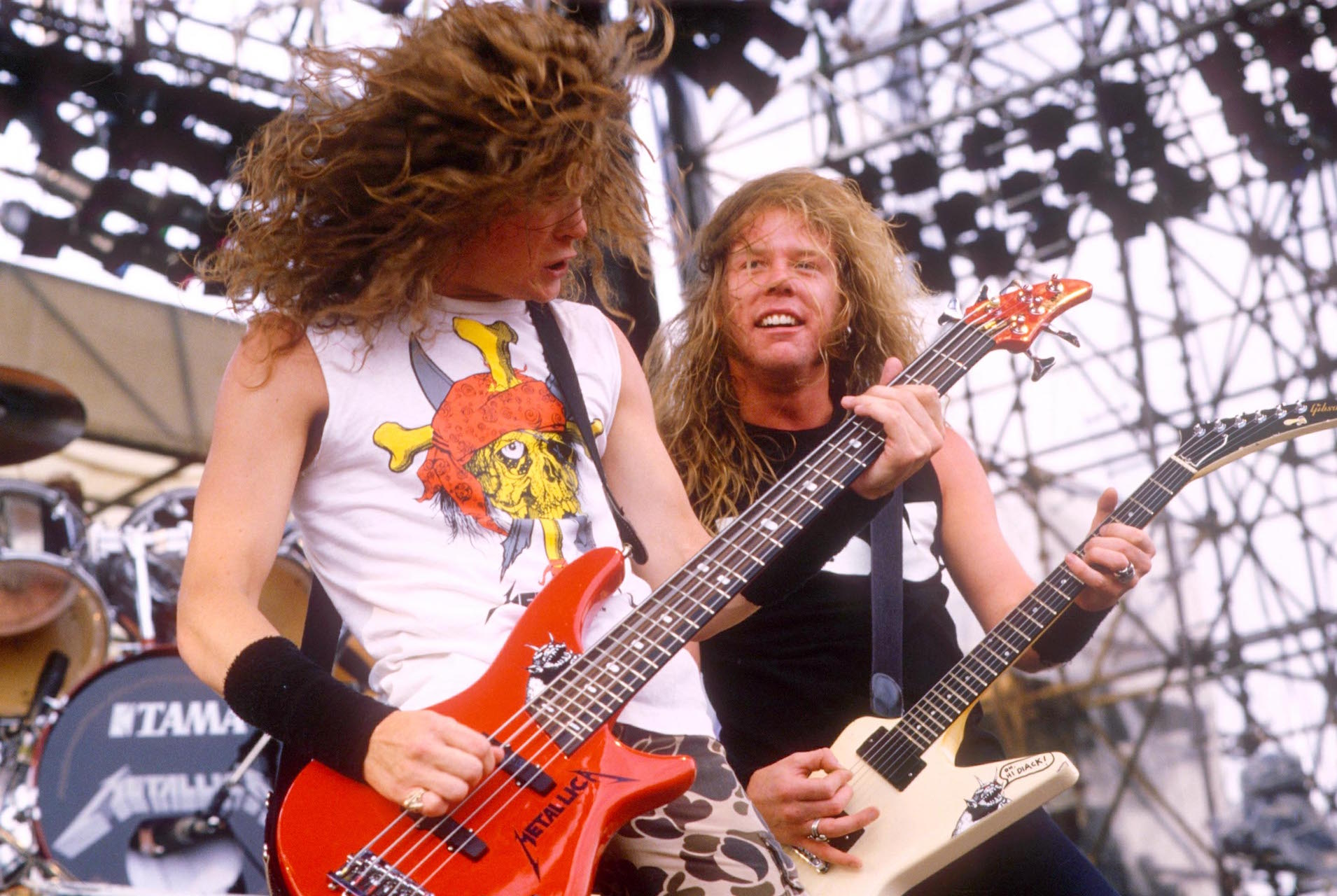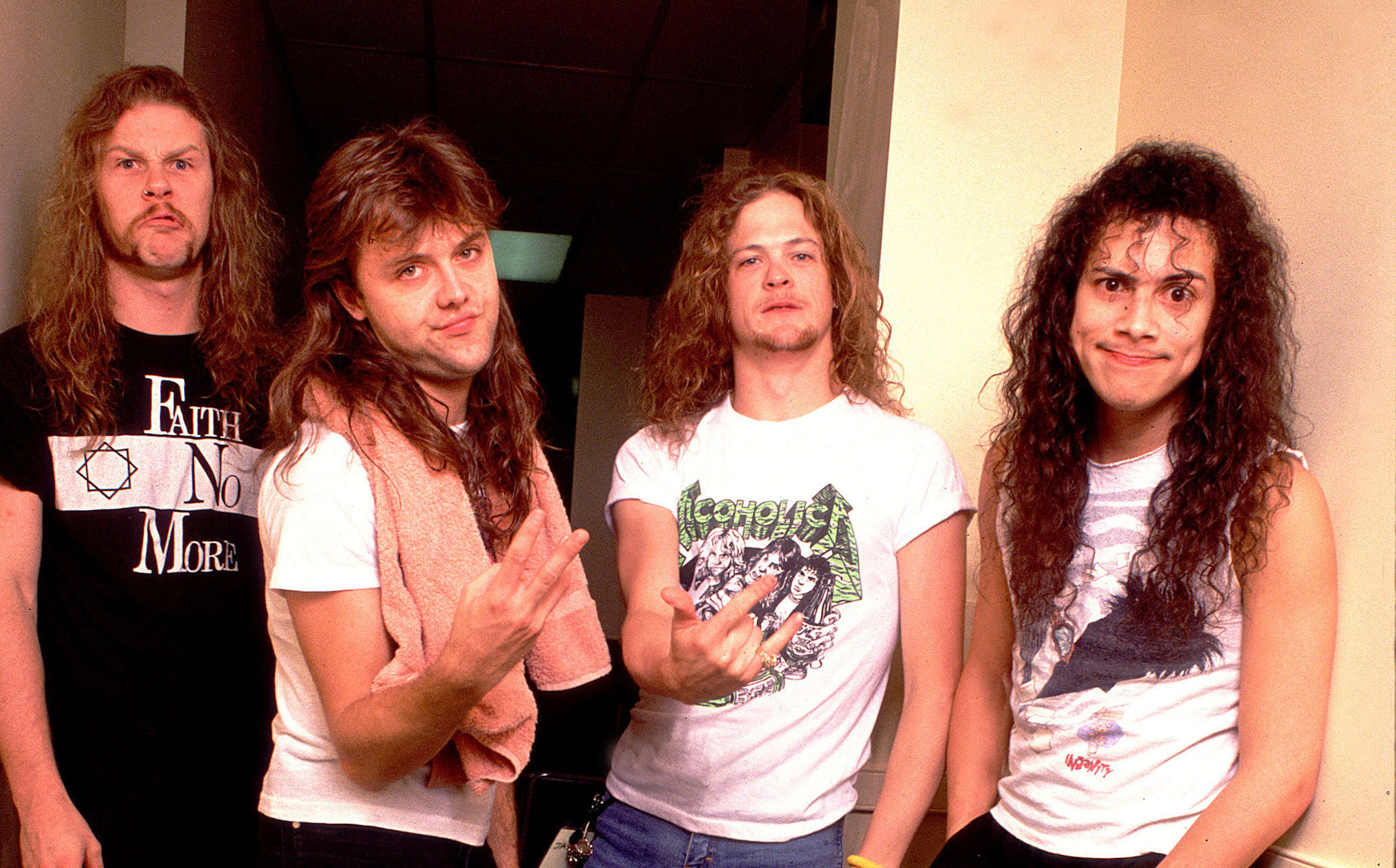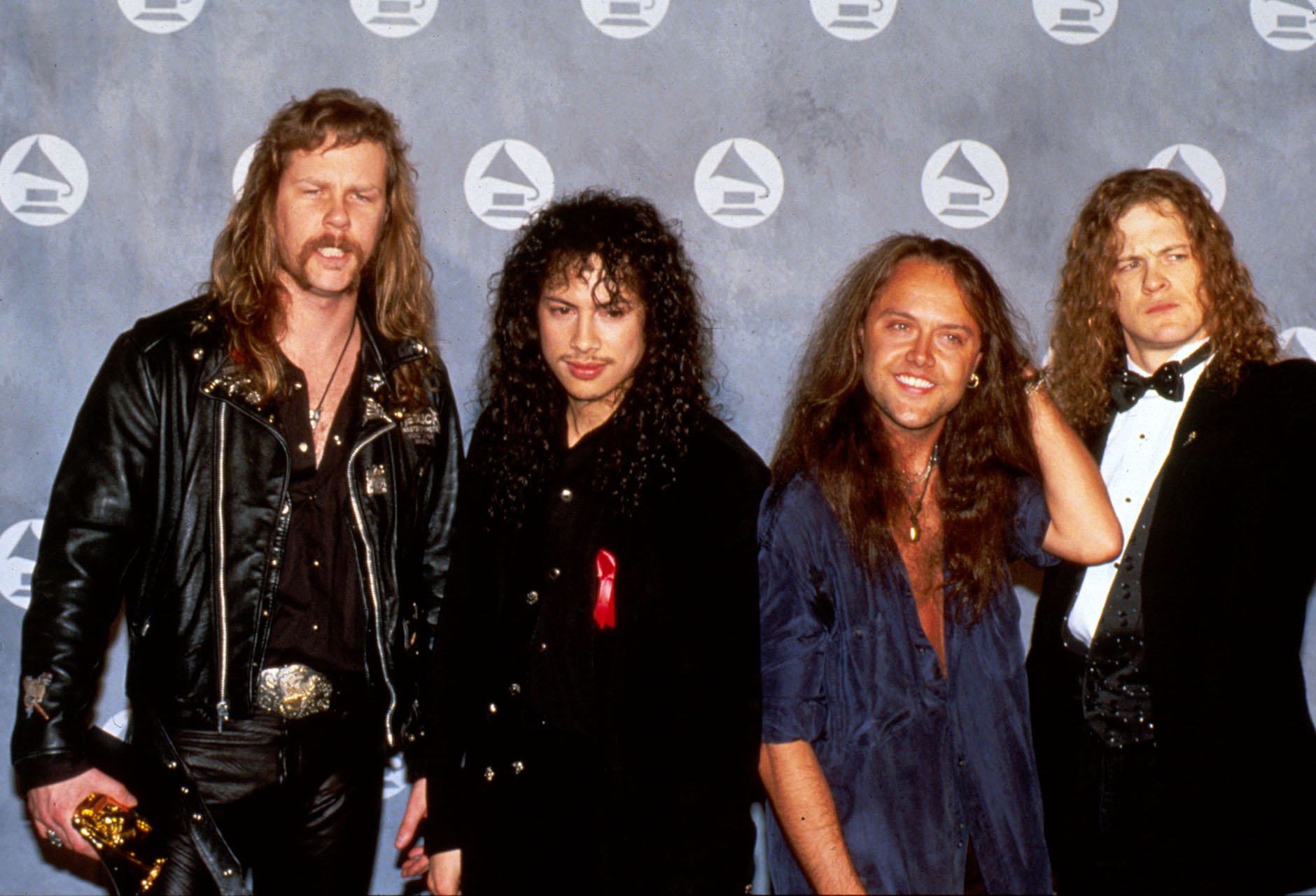This feature originally appeared in Classic Rock #124.
“We used to start drinking when we woke up. We’d get the gig over by three o’clock, and then we’d have eight or nine hours to drink.” So said Metallica drummer Lars Ulrich in 1988. He was talking about the Monsters Of Rock tour – an infamous jaunt across the US, with Van Halen as headliners and Metallica and Scorpions in support.
“It was awesome. Girls knew we were part of the tour and wanted to fuck us, but at the same time we could blend in with the crowd… There are pictures of us at the top of Tampa Stadium with our pants off, flashing everybody. It’s four o’clock in the afternoon and we’re already drunk off our asses. The not-giving-a-fuck meter was peaking.”
Singer James Hetfield added: “That whole Monsters Of Rock tour was a big fog for me. Those were my Jägermeister days. It was bad coming back to some of those towns later, because there were a lot of dads and moms and husbands and boyfriends looking for me. Not good. People were hating me, and I didn’t know why…”
In 1988, Metallica were the world’s heaviest, intoxicated, most-falling-over-a-lot partying machine. And, despite having a new bass player in the shape of Jason Newsted in the fold, Ulrich, Hatfield and Hammett were still struggling with the devastating loss of their former bassist and guiding light Cliff Burton in a coach accident on September 27, 1986.
“There was so much anger because of Cliff’s death,” Hammett said. “That kicked the drinking up two or three notches. Between 1987 and 1990, we were raging alcoholics.”

1988 was also the year when the band released their fourth album, …And Justice For All. Snapped up by headbangers worldwide, the record was hotly anticipated thanks to its phenomenal predecessor, Master Of Puppets.
Justice… was a revelation: the length of the songs on the album, the complexity of the arrangements and the sheer riff count per tune made jaws drop. This wasn’t a thrash metal record, but it wasn’t strictly a heavy metal record either – it was, we realised later, one of the first examples of progressive metal.
However – in typical fashion – Hetfield and co were already looking for a new direction when Justice… hit the shelves. Just as they’d perfected a raw version of thrash metal in 1983, before dropping it like a hot potato in favour of a new, sophisticated direction Metallica had grown tired of the endless prog-metal noodling of Justice… almost as soon as it was recorded – and went on to something completely different.
“I have different relationships with …And Justice For All,” mused Lars Ulrich in 2005. “Sometimes when I hear it, I sit there and roll my eyes – and other times, I think, Jesus, this was the blueprint for a whole new generation of music.”
He’s right. Justice had its flaws, but you can hear its influence on a dozen different metal bands that followed. In a radical step away from Metallica’s previous three albums, Justice… sounded cold, clinical and sinister, with Hatfield’s huge rhythm guitar parts dominating the sound. Fans of the new, then-bassist Jason Newsted weren’t happy with the mix, which reduced his contribution to a minimal rumble – an especially odd move given the huge bass sound of 1987’s The $5.98 EP: Garage Days Re-Revisited, which Metallica had recorded specifically to showcase Newsted’s phenomenal skills.
It’s the absence of bass guitar on …And Justice For All that is its most revealing feature to this day. If you want an insight into the mindset of James Hetfield and Lars Ulrich – now and forever Metallica’s leaders, no matter what the PR spin suggests – you could do worse than ask yourself why they chose to take the bass out. For one thing, it’s possible that Lars and James were still uncertain of Jason’s ability to step into the shoes of Cliff Burton.

Perhaps Jason’s bass parts weren’t quite up to scratch, as he himself implied: “I stepped into the studio with an assistant engineer, and I had the same gear that I would just play on the stage. Basically, I was doubling James’s guitar parts, because that’s the kind of bass player I was then. Lars and James weren’t around to say: ‘You should try this there instead of that.’ It was the first time we’d been in the studio for a real Metallica album, and Cliff’s not there. They’re juggling producers. There’s no order… even though we had the money. And the support of the label. Even though we had a nice studio. None of that was in order.”
Most crucially, Newsted’s bass parts were faded almost completely out of the album by the mixing team of Steve Thompson and Michael Barbiero, on Lars’s and James’s instructions. Ulrich and Hetfield’s judgment may have been hindered by the small matter of the Monsters Of Rock tour on which Metallica were playing at the time, as Jason explained: “We go on this tour with Van Halen and Scorpions – the guys who invented partying, [with] piles of powder here and there, and all that shit! That was the first taste for us of dipping your foot in the actual scene of rock’n’roll, you know…
“So we’re doing a few shows a week with those guys on that special festival, and on the days that we aren’t, James and Lars are flying to the studio in New York to mix the record with these two other cats [Thompson and Barbiero] that I never met in my life… So they’re partying, travelling back and forth, getting no sleep, going there early with kind of an attitude about the bass, [under his breath] ‘It’s not Cliff’, and yadda yadda – and they go in and tell the dudes: ‘Get the bass just where you can hear it, and then take it down a half a decibel. Then turn all the frequencies up on the guitars… and then try to make the bass drum to fill in all the space, so it can be all percussive.’”
“After Justice… it was pretty apparent that we needed some guidance,” Hetfield agreed later. “I’m not knocking it. It was right at the time. But the drums are really loud and the guitars are really loud. That’ll be me and Lars, then…”
When the album was released and Newsted heard it for the first time, he was speechless. “I was so in the dirt. I was so disappointed when I heard the final mix – I basically blocked it out.” What’s more, Jason knew he couldn’t kick up a fuss: “We were firing on all cylinders, and shit was happening. I was just rolling with it and going forward. What was I gonna do? Tell them we gotta go remix it, when we were down to the last minute?”
In retrospect, the odds of Newsted’s bass parts being taken seriously were stacked against him. He was perceived at the time as the ‘Newkid’, the target of a year’s worth of hazing from the rest of the band, and was the guy who was trying to step into the virtuoso Burton’s place. Perhaps most importantly, Lars and James – still only in their mid 20s, and used to being in complete control – were able to override Jason, because he wasn’t as outspoken or as opinionated as Cliff.
- Remember when Metallica secretly supported Metal Church in 1990?
- Metallica: The Making Of Kill 'Em All
- How Metallica ruined my life
- The 10 most underrated Metallica songs...
Meanwhile, Kirk sighed: “I wish that we would have recorded …And Justice For All better. At the time it seemed like an interesting concept. But that album just doesn’t sound good to me nowadays. I love the songs, but the way it sounds is funky. Funky as in bad, not funky as in groovy.”
It’s not surprising that the band grew to dislike Justice… With its self-indulgent nature – the title track is nine minutes long – it’s a young man’s album, with a railing, rebellious tone that reveals its creators’ relative inexperience. It also contains Metallica’s last real thrash metal song, Dyer’s Eve. Thrash can only be played with conviction if you’re young or angry, ideally both, and by the end of the 1980s Metallica had matured enough to make the idea of playing fast, violent music seem a little, well, juvenile. Although they’d headed up the ‘Big Four Of Thrash’ along with Megadeth, Anthrax and Slayer, the fact was that Metallica had been less and less enamoured of the speedy moshpit stuff since 1984’s Ride The Lightning, which had featured a ballad (Fade To Black) and mid-tempo, mainstream metal like Creeping Death and For Whom The Bell Tolls. Even the flawless Master Of Puppets only contained two real thrash songs – Disposable Heroes and Damage, Inc. Whatever came next, it was unlikely to be any form of extreme metal.
The Monsters Of Rock tour ended in July 1988, and the Justice… album was released in September. After the usual round of press, Metallica – or Alcoholica, as they’d been dubbed – embarked on a huge world tour, the Damaged Justice jaunt, which swept through the UK in the autumn and continued through almost the whole of 1989. The huge, blindfolded statue of Lady Justice from the Justice… album sleeve towered at the back of the stage, with a clever lighting rig masking the fact that it was made of polystyrene. As the set progressed, bits of her fell off, symbolising the death of the American legal system. Metallica had tried hard to create a live show that rivalled those of contemporary acts such as Iron Maiden, but it didn’t quite work out that way. It was clearly time for a change.
“When we came back from touring on that record in 1989, we were like: ‘We have nothing more to offer on this side of Metallica,’” Lars told MTV. “There was no place else to go with the progressive, nutty, sideways side.” And it’s not hard to see why. Hammett recalled that audiences hadn’t enjoyed some of the onger songs from the Justice… album, and James explained: “That album, songwriting-wise, it was just us really showing off and trying to show what we could do… We mixed that record while we were on the road. That’s not an excuse for the way that it sounds, but our ears were beat.”

Metallica’s collective hearing might have suffered after all the on-stage decibels, but there was nothing wrong with their artistic ambitions or their business sense. In a move that shocked thousands of their fans, the band made a video for …And Justice For All’s second single, One, despite previous boasts that they would never succumb to MTV in this fashion. Stark and more than a touch pretentious, the video depicted the four men moshing in a warehouse in-between clips of the 1971 film Johnny Got His Gun, a bleak depiction of a soldier who had lost his limbs and sight on the battlefield. Thanks to the video, the song quickly gained the most exposure of any Metallica song to date – and it was even predicted that the stuffed shirts behind the Grammy Awards would award Lars, James et al a gong in ’89 for the Justice… album.
However, this was not to be: despite playing One at that year’s awards ceremony and putting on their best suits for the occasion, Metallica were snubbed – the board opting in their infinite wisdom to give the Grammy (the first for Best Hard Rock/Metal Performance) to the decidedly un-metal, un-hard rock band Jethro Tull. The veteran folk-rockers received the award for their Crest Of A Knave album, a record which featured synthesisers and a drum machine. Yes, that heavy.
Despite this setback, the die had been cast – and the message had been delivered to the fans that the record industry was taking Metallica seriously at last. And One did eventually go on to scoop its own Grammy, Metallica’s very first, in 1990. The times, they were definitely a-changing.
After completing another short Monsters Of Rock run in June 1990, Metallica found themselves considering their future. Their career to date had produced four albums and an EP, with the last three albums engineered and/or produced by Flemming Rasmussen, the Danish producer whose expert console-tweaking had brought the very best out of them. Lars and James had seriously thought about using different producers such as Mike ‘Appetite For Destruction’ Clink, employing him for the initial Justice… sessions and replacing him with Rasmussen when it became obvious that Clink wasn’t going to work out. For album No.5, however, the band were determined to make a break from Rasmussen, and recruited Bob Rock, the Canadian producer who had worked with Mötley Crüe, The Cult and others.
More than anything else, the news that Metallica would be working with Rock on their next record was a sign that changes were afoot. Despite the nervousness of the thrash metal fanbase, Metallica didn’t care: their choice of Rock as producer reflected their desire to simplify their music and achieve a bigger sound than the weird, processed riffage of Justice…
Rock took Metallica’s sound by the scruff of the neck, added a fat low end to the production and fought daily with the band over every detail of the album. “In retrospect the months we spent in the studio were pure hell,” Lars admitted in an interview on Eagle Vision’s Classic Album DVD. “We were just really reluctant. The door was open just enough for Bob to open it more and pull us through. It became about a vibe and a moment.”
When Metallica was released on August 12, 1991, it immediately shifted vast numbers, helped along by the first single, Enter Sandman. Without that first single and its accompanying video, the record would have been a much slower mover: the song’s fat, radio-friendly guitar tone, its creepy arpeggiated intro and the central riff – conceived by Kirk and edited by Lars – was unforgettable. It also boasts a huge bass guitar presence: at last, Metallica had found their sound (and Newsted his proper role).
Enter Sandman marked the point when Metallica shed their skin (an appropriate metaphor, given the embossed snake on the album’s none-more-black sleeve), taking a step sideways out of the thrash metal shadows and upwards into the mainstream limelight. Like one of the mythical beasts they’d celebrated in The Call Of Ktulu and The Thing That Should Not Be, the Metallica monster threw off thousands of old-school thrash metal fans in favour of a new load made up of a younger, more enthusiastic fanbase.
Metallica’s older followers watched in horror as ‘their’ band suddenly became beloved of jocks, accountants, students, cheerleaders and grannies alike, most of whom would never dream of buying an album by, say, Slayer.
Sick to death of long, complex compositions which meandered from intro to solo to verse to chorus and back again, James and Lars – assisted to a small extent by Kirk and Jason – had composed short, snappy, effective songs which didn’t outstay their welcome and sounded positively poppy compared to the riff-salads of the previous three albums. Indeed, Metallica’s closest neighbour in the canon so far was Kill ’Em All, the 1983 debut album which had also featured tight, short songs, although they were much faster and rawer than the majestic-sounding tracks of the Black Album, as Metallica would become known.
The album’s big, big sound has become a gold standard in heavy metal. As the acclaimed producer Andy Sneap comments: “I thought the Black Album was great. I think they needed to mature as a band after …And Justice For All, and that Bob Rock was one of the best things that happened to them. When Sad But True starts in a nightclub it sounds amazing. It has the snare drum from hell!”
High points of the album included Sad But True, one of the heaviest songs Metallica had ever recorded: in terms of riff weight, only The Thing That Should Not Be is mightier. Check out Holier Than Thou, with its hooky chorus line – this song was suggested as the first single by everyone except Lars: the drummer insisted that Enter Sandman would make a better choice of lead-off release.
- Metallica: every song on the Black Album ranked from worst to best
- Jason Newsted: Life Beyond Metallica
- The 11 best Metallica videos
- The story behind Metallica's Black Album artwork
With Nothing Else Matters, Metallica took a deliberate step out of the metal scene and into chart-rock. The song, a gloopy ballad with James singing softly rather than harshly, expresses his love for his wife and builds towards a major climax at its end, with Hetfield delivering a rare guitar solo. You could play this song at a wedding, and thousands of couples have done just that. Older fans were appalled.
Most bizarrely, the Black Album was an arty record, with Metallica abandoning the fast pace of thrash metal to hone a new, mid-tempo sound and dressing it up in conceptual imagery. In The God That Failed, for example, Hetfield moved from commenting on social ills such as warfare and drugs in his lyrics to more personal subjects. “I did have a pretty huge problem with religion growing up, Christian Science, [and the] pretty strict rules that I’d had in my youth and growing up, not fully understanding the religion…” James admitted.
“As a kid it didn’t make sense to me, and I battled it quite a bit through my teens and 20s, and it kind of messed with my head.
“It just got a little too easy to keep writing lyrics like the Justice… shit. It’s too easy to watch the news and write a fucking tune about what you saw. Writing shit from within is a lot harder than writing political shit, but once it’s out it feels a lot easier to put your weight behind, especially live.”
Lars was moving on musically too, going as far as to take some drum lessons – after coercion from Bob Rock. Kirk had also matured in the pre-Black Album years, moving away from his shredmongous past for a new, more economical approach. “Guitar players in the 90s seem to be reacting against the technique- oriented 80s,” Hammett said. “I just had to say, screw everyone around me – from now on I’m just gonna play what I think is important to me and our music. So
I gave the big finger to all the current trends for technical wizardry, and just went off and did what I felt was best for the songs.” He later added: “When we were making Metallica, nobody even knew who the fuck Kurt Cobain was,” revealing that he kept his eye on the competition.
Musical evolution aside, the Black Album was a decidedly arty piece of work compared to the albums that had preceded it. The sleeve, with its iconic all- black art, was itself a statement; the portraits of the band inside were solemn and unsmiling; and the liner notes were sober, with none of the ‘Hella thanks to…’ and ‘No fuckin’ thanks to…’ exuberance of previous releases. Critics were initially surprised by the vast step away from their roots which Metallica had taken, but the response was good, if not yet gobsmacked: even Rolling Stone were mildly enthusiastic, writing: ‘Several songs seem destined to become hard-rock classics.’ Others failed to understand, with Entertainment Weekly labelling it ‘progressive thrash’, a genre applicable to the previous album but not to Metallica.

Like many great albums, the Black Album needed time to settle into the popular consciousness before people realised its true impact. This was assisted by the three years of relentless touring that followed its release, during which Metallica reduced their booze intake a little – although James later claimed to have forgotten entire gigs after too many shandies – in order to stand the relentless pace.
Five more singles were released after Enter Sandman and for three whole years there seemed to be nothing else in heavy metal but Metallica. The album’s success was practically a miracle. Pundits may prefer Master Of Puppets, but then the pundits weren’t queuing up to buy the albums – the fans were. Tens of millions of them.
Blabbermouth webmaster Borivoj Krgin recalls: “At first, it was weird hearing Metallica playing songs that were arranged in a more traditional way – verse, chorus, verse, chorus, lead, and so on – but the strength of the material once again shone through. The production was by far the best they’d ever had up until that point. It was the right record at the right time, and once again, Metallica were ahead of everyone else when they decided to streamline their sound and make it easier to digest by the masses. I remember other bands – particularly Testament – struggling to make the same change in their sound after the Black Album was released, but they didn’t have the same songwriting skills as Metallica to pull it off.”
It’s possible that Metallica wouldn’t have been such an almighty hit if it hadn’t been for its fortuitous timing, of course. 1991 was a Year Zero for heavy music – the year when grunge hit the mainstream in the form of Nirvana’s Nevermind; when funk-metal (which begat nu metal, depressingly) went supernova in the form of the Red Hot Chili Peppers’ Blood Sugar Sex Magik; and when thrash and hair-metal were both crushed into meaninglessness for the next few years by the impact of Metallica. These three albums redefined the rock landscape between them, in a brief moment that defied all three bands’ subsequent attempts to scale the same heights a second time. Metallica in particular suffered not a little from the vast success of the Black Album, emerging in the mid 90s to find that they were players in a field of one, with their contemporaries gone or evolved out of heavy music. A 1992 tour with Guns N’Roses – which included a fateful date in August when Hetfield endured second and third-degree burns when he got too close o on-stage pyrotechnics – had been a moderate, rather than significant, success.
The best way to remember those key years in Metallica’s development is to consider what they taught us. The band have always made an awful lot of noise about doing what they want, when they want, with no pressure from record label or management into directions that they don’t wish to pursue. The switch they made from prog-metal to straight-ahead heavy metal between …And Justice For All and Metallica was risky: fans of thrash metal might have deserted them, while the legions of new metalheads might have attended the church of Cobain instead. As it turned out, James’s and Lars’s new songs had the hooks and the riffs to pull in the masses, and Bob Rock’s production sheen meant that the Black Album still sounds contemporary today.
Other metal bands have tried and failed to replicate Metallica’s leap from the extreme to the mainstream, and no one else has managed it without losing their fans, receiving a ton of abuse from the critics, or both.
Maybe the most penetrating comment on this key three-year period of reinvention came from Jason Newsted, who told us with admirable understatement: “Things were considerably different with the Black Album. A lot was learned in those three years. We came leaps and bounds in those years, didn’t we?”
They did indeed.

